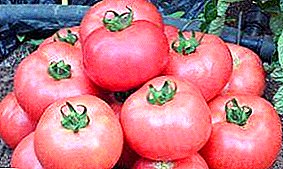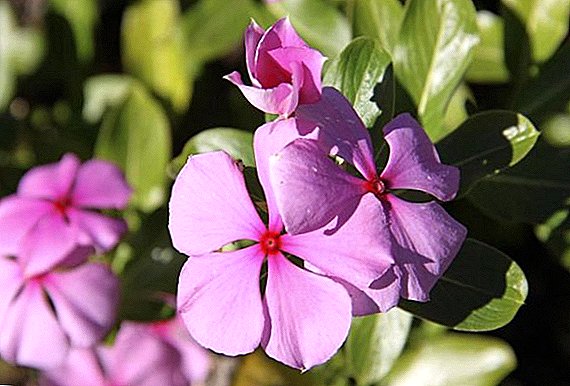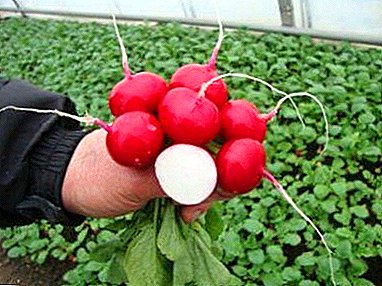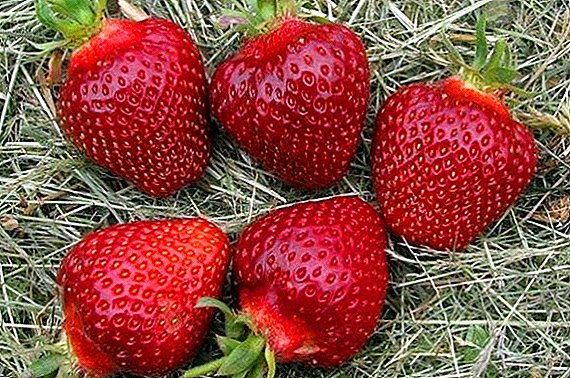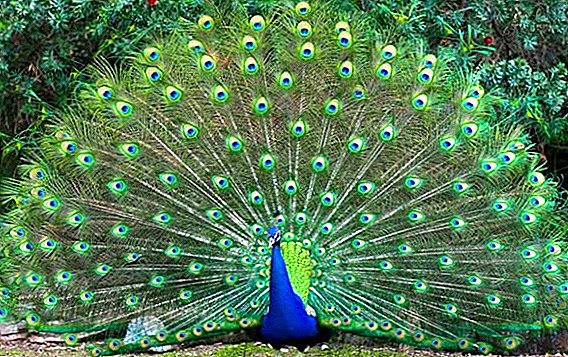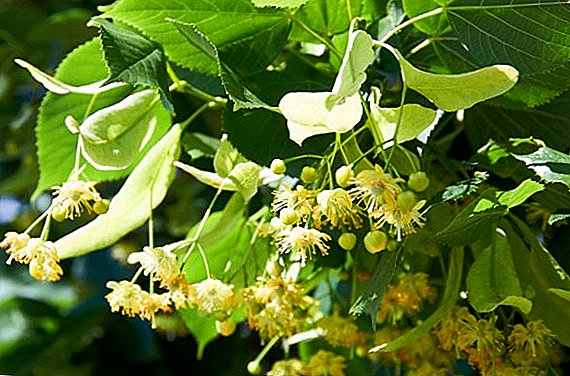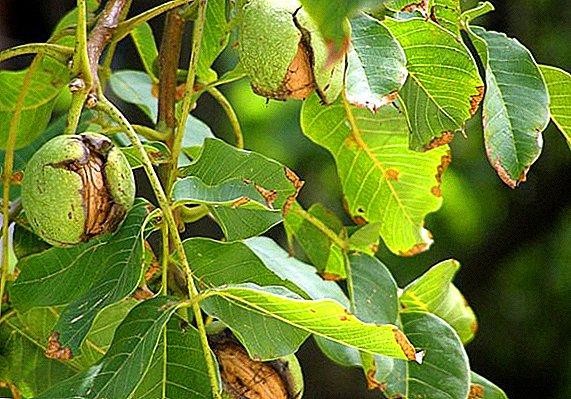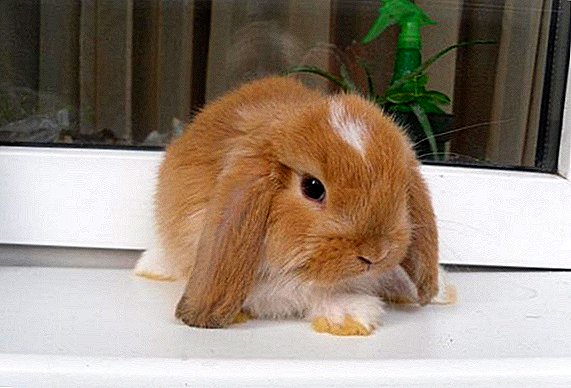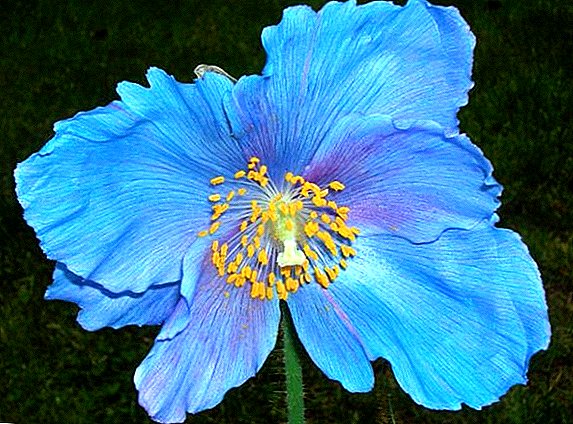 Traditionally, mentioning poppy flowers, we mean a bright scarlet, deep red color. The scarlet color of the flower is symbolic, and often the image of the poppy in the decor has a certain meaning. However, nature is very diverse, and in this article we will tell you that there are poppies of blue, orange and yellow flowers.
Traditionally, mentioning poppy flowers, we mean a bright scarlet, deep red color. The scarlet color of the flower is symbolic, and often the image of the poppy in the decor has a certain meaning. However, nature is very diverse, and in this article we will tell you that there are poppies of blue, orange and yellow flowers.
Botanical description
Meconopsis (Meconopsis) - a bush with sky-blue flowers, belonging to the family of Macs. It is also called the bell-shaped poppy, Himalayan, Tibetan and blue poppy.
This amazing flower comes from the Himalayas, but the British began to grow it as a landscape gardening culture. Blue poppy is considered to be a symbol of happiness, peace and harmony in Bhutan, where it is recognized as a national symbol.
The meconopsis has a flower up to 5-7 cm in size, but there are also large species with a opened bud of 10-25 cm in diameter, with petals of a rich blue color. The bush has in its lower part a rosette of round leaves with a long petiole. The leaves are painted in light shades of green, the edges are solid and smooth.
Learn how to grow papaver peony, Oriental poppy, opium poppy.
 The upper leaves are oblong. A single stem can reach 25 cm, on top of which stands a flower or inflorescence of several buds. Most of the plant, its stem and leaves are covered with small hairs or the edge of a gray or brown color.
The upper leaves are oblong. A single stem can reach 25 cm, on top of which stands a flower or inflorescence of several buds. Most of the plant, its stem and leaves are covered with small hairs or the edge of a gray or brown color.Plant shoots appear warming in the middle of spring. And in June, meconopsis pleases the eye with its flowers. The flowering process lasts about a month. Since the plant is perennial, in 2-3 years of growth, the plant turns into a shrub.
Every year, with the onset of the first cold and frosty days, the ground portion of the meconopsis dies. The root system remains unchanged, and when nature awakens, sprouts begin to break out of the root buds, and then the bush revives, increasing its size. Oily seeds of a grassy plant ripen in a fruit-box when it dries.
Important! Mekonopsis is included in the group of poisonous plants, as it contains a milky sap that has a narcotic effect.

Distribution and habitat
The area of distribution of the blue poppy does not have a single territory, it is interrupted, so that there are certain external differences of plants. Originally from the Himalayan mountains, this explains one of its names, where about 40 of its species are known. In the Himalayan range, you can meet the sky-blue maca, saturated blue, bright red, creamy yellow and white. They can have one flower or decorate the bush with inflorescences.
But there is a kind of meconopsis, which can be found only in England, Wales and Ireland - Meconopsis cambrica, Cambrian poppy. Most often it has shades from light to juicy orange.
In wildlife, you can see meconopsis in shady forest areas, in alpine meadows, with sufficient moisture. They are common in Nepal, Bhutan, in selected regions of China and Tibet.
In the modern world, meconopsis flowers are used by florists in landscape design, in addition, plantings of blue poppies can be found in many countries, including Australia, New Zealand, Japan, Canada, USA, Western Europe.
Important! Mekonopsis are afraid of hot dry air and insignificant precipitation.

Types of meconopsis
We will tell about the varieties of meconopsis:
- spiny meconopsis, or Bailey (Meconopsis betonicifolia) - grows in the Himalayas. This type of plant is the most common and recognizable. Its flowers are painted in blue, and varieties and hybrids surprise with a variety of shades and sizes. As a rule, a flowered poppy flower has a diameter of 7-10 cm, and the bush reaches a height of 60-100 cm. The flowering period lasts only a month - from June to July. And the seeds ripen in late summer. This type of grassy shrub is fairly cold-resistant and tolerates temperatures up to -18 ° C;
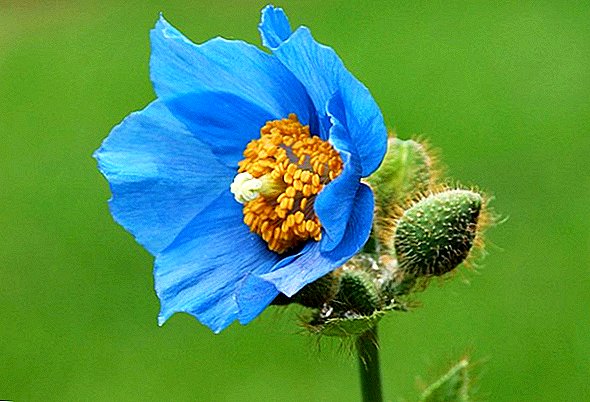
- meconopsis large (Meso nopsis grandis) . The plant prefers open areas of high-mountainous pastures of the Himalayas at an altitude of more than 3 thousand meters, the edges and edges of forests. It can be found in Nepal, Tibet and Bhutan. This species is slightly lower than Bailey and is 50–60 cm high at the time of flowering. Flowers can be blue, blue, purple, very often with a hint of mauve or pink. Peduncles rather miniature, only 12-15 cm, topped with large flowers, the diameter of which is 8-12 cm. Flowering begins in the second half of June and until the beginning of August. The plant is able to withstand temperatures down to -20 ° C;

- Cambrian meconopsis (Meconopsis cambrica). This type of amazing poppy can be seen on the territory of Iceland, England, Wales, Western Europe and France. It is low, its height reaches 50 cm. The flower is very similar to the classic poppy, 6 cm in diameter, but has a bright yellow and orange color. Some varieties of this plant species have terry petals. Kambrian poppy pleases with its bloom the whole summer. It is very unpretentious, because it can withstand cold temperatures up to -23 ° C, and also, unlike many of its relatives, grows normally in sunny terrain, although it prefers a humid climate;
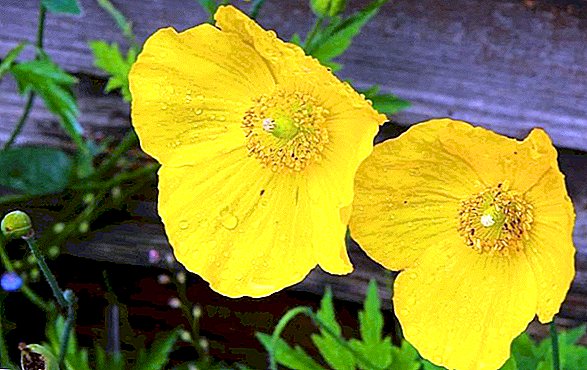
Did you know? Mekonopsis - means "like maca". The term appeared during the travels of the famous scientist N. Przhevalsky on the territory of Central Asia in 1885. In his notes, the scientist called the plant a Tibetan miracle and a Himalayan poppy.
- meconopsis sheldon (meconopsis x sheldonii) - a perennial hybrid, obtained by crossing the Grandis and Betonicifolia. Plant height can be 1-1.5 m. Azure-blue flowers delight the eye from June to August. It tolerates cold weather;

- meconopsis caravella (Meconopsis x karavella) - A hybrid with luxurious double flowers, the color of which can be yellow, terracotta, orange, their colors and even a combination of several colors at the same time;

- five-line (Meconopsis quintuplinervia) - poppy, the flowers of which have a bell-shaped form of purple hues. Flowering lasts from May to early autumn. In the winter cold, a bush on the surface of the earth dies or is pruned, and in spring sprouts appear from root buds;
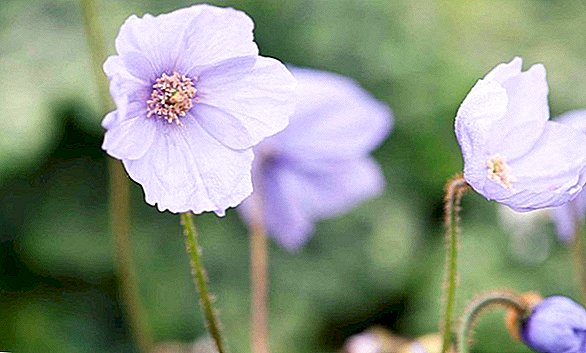
- Nepali (Meconopsis napaulensis) - tall shrub reaching two meters in height. Flowers have a bright pink, red, purple color. The plant is monocarpic and begins to bloom only after 3-4 years. Grows at an altitude of 2500-5000 m in Nepal;

- paniculata (Meconopsis paniculata) - with rich buds, painted in bright yellow tones. Large flowers with a diameter of 8 cm have the form of a bowl. The plant grows in the Himalayan mountains. You can catch it blooming just a month in the middle of summer;

- purple-red (Meconopsis punicea) with separate drop bells, painted in purple-lilac colors. The length of the petals is 10 cm. It prefers partial shade, damp grassy meadows and slopes. In nature, it occurs at an altitude of 3000-4500 m. It was first encountered in Tibet. Propagated by seeds, but good germination is provided only in autumn sowing.

Use in landscape design
Himalayan poppy - exquisite decoration of every corner of nature. Landscape designers prefer to plant this plant, creating rocky compositions in the form of rock gardens, combining with other mountain plants, rockeries, miniature rocky complexes.
Meconopsis bushes are very thick and look spectacular as a frame for a pond. They are often used as an element of a mixborder, a complex multi-tiered flower garden, consisting of many plant species, which, with proper selection and organization, are a constantly-blooming composition from the first days of spring to the first frosty days.
Learn how to create rock arion, rabatka, mixborder, alpine slide, flower and stone flower bed, fountain, dry creek, front garden.The meconopsis looks great on monoclumbus. The combination of multi-colored flowers of this herbaceous plant surprises and delights. Grown in the frame of ornamental shrubs, blue poppies make a special impression.
In the absence of flowers, its lush bushes also perform a decorative function. Meconopsis are often planted, interspersed with such garden crops as clematis, ferns, akvigelii, hosts, foxgloves, brunners, and low cereal plants. 
Growing and caring for plants at home
Breeding Himalayan poppies is quite troublesome. The plant is rather demanding in terms of conditions, it needs a humid climate, the absence of direct sunlight in its natural habitat.
Conditions of detention
Blue poppy prefers cool weather and humidity due to its natural habitat. Dry air, high temperatures create conditions under which this plant does not bloom and dies. In hot weather, the flower must be sprayed. And the best place to grow it in the garden are shaded areas, but without stagnant moisture.
Shadow-loving astilbe, aconite, brunner, dicentre, doronicum, Volzhanka, saxifrage, bathing lily, lily of the valley, lupine, rogersija, cyanosis, and the host can become neighbors at the place of growth of meconopsis.For cultivation of bell-shaped poppy or its hybrids in non-production conditions, you should purchase its seeds in a special store. At the end of winter, optimally in February, the seeds are planted in plastic containers for growing seedlings. Capacity with the ground expose under the scattered rays of the sun in the room. It can be an apartment or a greenhouse.
If you want to grow meconopsis in the open field, on a plot near a country house, it is best to sow the seeds at the end of the summer and autumn months. Wintering in the soil, they will give their shoots in the spring. 
Soil and fertilizer
The soil must be chosen to be slightly acidic and moderately nourishing, it should be loose. It can be purchased at a store specializing in landscaping and selling seeds and seedlings, after consulting with a specialist, or prepare it yourself. To do this, you will need to mix one portion of sod land, leaf and sand, and then combine with 2 portions of peat.
You may need some knowledge: how to determine the acidity of the soil, how to deoxidize, how to disinfect the soil, how to use perlite and vermiculite for plants.Mixing all the components, the soil must be disinfected, and the easiest way to do this is a solution of potassium permanganate. There is also a method of preparing the soil by heat treatment with steam to kill fungi, moss spores and pests.
For planting seeds, you can use a special container or another suitable container in which you need to make a hole to improve the flow of water. At the bottom should be placed a layer of drainage, which can serve as a brick crumb or small pebbles or shells, then splinters of trees. Cover the drainage with prepared soil or purchased subacid substrate. 
Watering and moisture
Himalayan poppy loves to grow near water bodies, in parts of the penumbra, protected from strong winds. When breeding meconopsis, you should avoid drying out the soil by mulching with green mass, peat, sawdust, bark, compost.
If the topsoil is very dry, there are cracks in the ground, then the plant must be plentifully watered, otherwise it threatens the death of the flower after flowering. The grassy poppy plant is sensitive to moisture levels. Imbalance can weaken the plant and destroy it. Watering should be done no more than 1 time per month, carefully monitoring the condition of the soil.
Relation to temperature
When growing seedlings and saplings, it is imperative to observe the temperature conditions, the air should be about + 10 ... + 12 ° C, but not more than + 13 ... + 14 ° C, which can provoke the death of the plant. Fresh and cool air will help prevent mold.
When landing in open ground, the weather should also be cool and wet, ideally, if it happens after rain. Shade will provide the plant with a good adaptation to the new place of growth.  Most species and hybrids of meconopsis tolerate even very cold weather very well, the air temperature can drop to -18 ... -23 ° C. In the fall, the bush is pruned at the root, and in the spring it releases new shoots.
Most species and hybrids of meconopsis tolerate even very cold weather very well, the air temperature can drop to -18 ... -23 ° C. In the fall, the bush is pruned at the root, and in the spring it releases new shoots.
Poppy breeding
To increase the plant population in several ways: vegetatively, by dividing the bush and grafting, and seeds. Both methods can be effectively used in breeding meconopsis at home, but let's consider the reproduction characteristics of this plant.
Seeds
Seeds of Himalayan poppy can be harvested by yourself, picking the fruit box at the end of the summer season even before the seeds fall, or you can buy it in the store. It is better to store them in a refrigerator until spring. In the case of the purchase of seeds in a specialty store, before planting, they will need to be subjected to a stratification procedure 45 days before diving into the ground.
Learn how to save space and soil when planting seedlings.Seed reproduction at home is a rather lengthy and troublesome process that requires careful preparation of the soil, creating cool and moist conditions for germination, transplanting seedlings to open ground. Seeds can also be sown immediately in the soil in the autumn, where they, after wintering, will give their first shoots.

Did you know? 3000 meconopsis seeds weigh only 1 g.With seed propagation, species plants retain their properties well. Planting seeds at home in a container for seedlings, they are placed in the ground no more than 1.5-2 mm, easily pressing your finger into the soil. Germination time can last from 1 to 3 months. The blooming of the Himalayan poppy when it is grown from seeds can be observed in 2-3 years.
Vegetative
Dividing bush carried out in the period when the plant is in resting mode. Root system inspect, remove shoots, dead and injured roots. Next, division into parts occurs so that each has roots, a bud, and an emerging rosette. After the division, all parts are transplanted into the ground, watered, create shade and care.
It is better to land on a long-term place of cultivation in early spring, as soon as the snow melted, and the soil is still quite wet and cool. The bush can be divided twice a year: after the snow melted in early spring, and also in August in the area where this period is not very dry and hot.
Cuttings - Another way of breeding mekonopsisov. To do this, young shoots with roots and heels are separated from the socket of a mature bush. New sockets need to grow in a greenhouse, for this fit a small room size. There they are cultivated, observing the conditions of moisture and temperature. 
Possible difficulties in growing
Growing conditions for Himalayan poppy should be as close as possible to the natural growth environment. Compliance with temperature and humidity is a very important aspect when growing seedlings. The plant is frost-resistant and does not require special shelter in the winter. We can not allow the plant to bloom in the first year of life, it can destroy it. Tall varieties need a garter.
Pests, diseases and prevention
Among the main problems that may arise with the cultivation of blue poppy, are the following:
- powdery mildew.
Elimination:
- removal of plaque from damaged areas of the bush;
- pruning heavily overgrown bushes;
- renewal of topsoil;
- treatment with special chemicals.

- aphid.
Elimination:
- treatment with insecticides, careful use of chemicals, because they kill not only pests, but also insects useful for the life of the plant;
- spraying the bush with herbal and vegetable decoctions. To do this, you can use wormwood, tansy, tomato tops, garlic, onions, dandelion, mustard;
- regular fertilizer use;
- choosing the right site for growing in compliance with all the necessary conditions.

Mekonopsis: reviews
Так как я недавно на форме, не знаю можно ли об этом писать, но у Михаила Полотнова на Вебсаде есть целая статья о выращивании меконопсиса.
Я никаких плясок, как Михаил, им не устраивала. Now mekonopsis already have 3 true leaves, not one, pah-pah, has fallen out.












